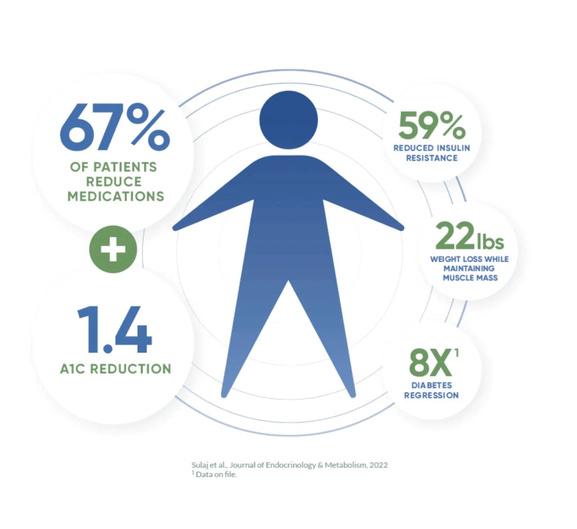UNLOCKING LONGEVITY
The Power of The Fasting Mimicking Diet



Thanks to advancements in medical research, humans live longer today than ever before While we have extended the "quantity" of life, this often occurs at the expense of its "quality " A focus on healthspan - a term used to describe the healthy years of a person ’ s life - is not just about living longer, it's about living better Healthspan means not just adding years to your life but ensuring those years are healthy, vibrant and full of vitality
To achieve both longevity and a high quality of life, we must explore the fascinating science behind aging and how our dietary choices influence this natural process How and what we eat can play a profound role in promoting both longevity and healthspan Over the past decades, science has uncovered the importance of a balanced and nutrient-rich diet, supplemented by prolonged periodic fasting, in promoting longevity
While water-only fasting has been shown, repeatedly, to produce lasting longevity benefits, there remains concern around its safety and ease of adherence. To address these concerns, the ProLonTM Fasting Mimicking Diet (FMD) has emerged as a groundbreaking solution. Born from 25+ years of scientific endeavor, spanning 18 esteemed universities, and bolstered by the generous support of the National Institutes of Health (NIH), which alongside other government agencies has provided $36 million in research funding. ProLonTM’s FMD represents the only commercially available FMD scientifically crafted to simplify and enhance the practice of prolonged fasting while prioritizing safety and practicality The groundbreaking nature of this product lies in its ability to maintain a fasting state while allowing you to enjoy nourishing foods This means you get to experience many of the benefits associated with fasting without enduring the challenges of long-term water only fasting
This eBook is your guide to understanding the science behind these dietary strategies, and how you can easily implement them into your lifestyle We’ll uncover the incredible benefits of fasting and the FMD, explore their mechanisms within the body, and provide practical insights on how to incorporate them into your life So, get ready to embark on a journey toward a healthier and longer life - one filled with energy, vitality and enhanced well-being



Fasting is an ancient tradition that has been practiced for cultural, religious, and healing purposes It has a rich history and its benefits have been touted by Hippocrates, Plutarch, Paracelsus, and Benjamin Franklin throughout the centuries While continuing to hold a significant place in various major religions, the last decade has seen an exponential growth in the research and overall acceptance of fasting, with intermittent fasting (IF) now presenting as the leading dietary strategy practiced in the United States (2020 Food & Health Survey, 2020)
The enduring popularity of fasting can be attributed to its numerous benefits, which span from enhancing metabolism and promoting weight loss to lowering the risk of chronic diseases like diabetes and cardiovascular conditions. (De Cabo & Mattson, 2019) Ongoing research into prolonged fasting has unveiled a wealth of exciting discoveries, including improved insulin sensitivity, reduced inflammation, and support for the microbiome, among other benefits (Sulaj et al , 2022), (Wei et al, 2017), (Rangan et al , 2019)
What is incredible is that ProLonTM’s FMD, is exhibiting many of the benefits of prolonged fasting, while still allowing the individual to consume food The investigation into FMDs began in the lab, examining yeast, a single celled organism Investigating yeast allowed for more mechanistic investigation of the cellular processes and effects of fasting (Brandhorst, et al , 2015) Researchers observed that periodic fasting not only extended the yeast’s lifespan but also made them more resilient to stress These observations were supported by evidence from other model organisms, demonstrating that pathways associated with longevity were conserved between organisms Periodic FMD not only boosted markers associated with stress resistance and longevity but also delivered a host of other health benefits. Finally, research was extended to humans, where researchers found that the FMD led to reduced risk factors for multiple diseases including diabetes, cancer and cardiovascular disease. (Wei, et al, 2017) Let's delve deeper into the numerous clinically evaluated advantages offered by the FMD
Heart disease remains as the top killer in the United States (Ahmad et al , 2023) The FMD holds exciting opportunities for heart health as studies show risk factors for cardiovascular disease are reduced after 3 consecutive cycles Specifically, a study showed a significant decrease in body weight, trunk and total body fat, and lowered blood pressure Importantly, when they evaluated subjects with increased risks, they found that FMD was more effective at improving fasting glucose, triglycerides, total and LDL cholesterol, and C-reactive protein (CRP) indicating the therapeutic potential for those at higher risk of cardiometabolic diseases. (Wei et al, 2017) A new study comparing the impact of the FMD and Mediterranean diet on cardiometabolic health revealed incredible findings Researchers discovered that four consecutive cycles of 5-day FMD over a four-month period (only 20 days of fasting) was as effective at improving cardiometabolic markers as four months of continuous adherence to the Mediterranean diet (requiring 120 days of dieting) (Crupi et al , 2023) What is even better is that the FMD preserved lean body mass, including muscle, in the process while the mediterranean diet did not We’ll get into why this is so incredible in a bit
L-Nutra Health for Diabetes systematically targets multiple. organ systems to rejuvenate the cells that are involved in the pathophysiology of type 2 diabetes.
Sulaj et al , Journal of Endocrinology & Metabolism, 2022
*Date on file
Roughly 131 million individuals in the United States are living with prediabetes or type 2 diabetes; that’s over a third of our total population (Statistics About Diabetes | ADA, 2022) The metabolic health benefits of the FMD hold great opportunities for these individuals In a trial with patients with diabetes, six monthly cycles of ProLon’s 5-day FMD significantly reduced hemoglobin A1c values and improved HOMA-IR levels, markers of how well your blood sugar is controlled overtime. (Sulaj et al., 2022) (Gayoso-Diz et al., 2013) (Goldstein, 2002) What’s especially exciting is that two thirds of participants reduced their diabetes medications after six cycles of the FMD, and the improvements in markers of blood sugar control were sustained for months after stopping the program which suggests the potential for diabetes remission and regression (Sulaj et al , 2022) As such, ProLon’s parent organization, L-Nutra, has developed a unique FMD protocol and support program for those with type 2 diabetes This program, called LNutra Health, supports those diagnosed with type 2 diabetes in leveraging the FMD and other important lifestyle changes to reduce or entirely stop their diabetes medications, putting their condition into regression or remission

The FMD has become especially interesting in the space of oncology, the study and treatment of cancer Studies of the FMD in mice have shown significantly reduced cancer incidence and delayed cancer-related deaths (Brandhorst et al , 2015) In fact, they found that multiple cycles of the FMD led to a substantial reduction in the number of tumors, and delayed the time to tumor onset.
Furthermore, a small trial of women with early breast cancer indicated that FMD is not only safe, but also enhances the effect of chemotherapy on the tumor response. (De Groot et al., 2020). Multiple emerging studies now demonstrate safety and reveal the benefits for use of the FMD in combination with cancer treatments including fewer complaints of chemotherapy symptoms (Valdemarin et al , 2021) (Fay-Watt et al , 2023) (Lugtenberg et al , 2021) It is important to note that the FMD utilized in these trials is distinct from the
commercially available ProLonTM FMD in a number of important ways, and those looking to utilize FMDs as part of treatment should consult with their medical provider Another great resource for those looking to use fasting mimicking nutrition programs in cancer care is the Create Cures Foundation, a non-profit organization that aims to combine standard of care therapies with integrative sciencebased approaches focused on nutrition and fasting.
FMD has also shown to suppress IGF-1, a growth hormone that when present in high concentrations has been associated with cancer development and mortality. (Shanmugalingam et al., 2016) It is recommended to maintain optimal levels of IGF-1 in the body to maximize health outcomes (Rahmani et al , 2022) In human trials, the FMD demonstrated a significant reduction in IGF-1 concentrations, suggesting the FMD’s ability to reduce its potential role in pro-aging and cancer risk (Wei et al, 2017)
Inflammation is associated with the development of numerous diseases (Kotas & Medzhitov, 2015) Research conducted with mice, revealed that cycles of FMD reduced the number of inflamed tissues, including inflammationrelated skin issues. (Brandhorst et al., 2015) Additionally, human studies have shown three monthly cycles of 5-day FMD significantly reduced levels of C-reactive protein (CRP) in humans, a well-established maker of inflammation. That same study showed a reduction in white blood cells (cells responsible for protecting you from infections) in those with higher C-reactive protein levels, indicating its impact on systemic immune response markers (Wei et al , 2017) (Rangan et al , 2019) These findings collectively underscore the potential of the FMD as a promising approach to curbing inflammation and its associated health risks

Over the past 3 decades we have seen an alarming 161% increase in Alzheimer's disease, underscoring the importance of maintaining brain health, cognition & mental sharpness (Li et al , 2022) But here’s the good news, early evidence suggests that the FMD may enhance cognitive function and potentially support conditions like Alzheimer's disease. (Mecocci et al., 2023) Mice fed the FMD showed improved cognitive performance, motor learning, both short and long-term memory, and promoted the generation of new neurons in the brain. (Brandhorst et al., 2015) Further preclinical studies have also demonstrated that FMD cycles reduced cognitive decline and Alzheimer’s disease
pathology indicating its potential benefits in patients affected with these conditions (Rangan et al , 2022) That same group is in the process of studying the effects of FMD in humans with mild Alzheimer’s disease Early reports have revealed that monthly 5-day FMD cycles are feasible and generally safe in that population. (Rangan et al., 2022) Additionally, in a survey of ProLonTM users, 67% of participants reported increased mental clarity and focus, and 61% reported greater energy levels. With these results in mind, FMD has the potential to impact brain and cognitive health of both healthy individuals and those at risk.
Hidden within your body lies a bustling metropolis of microscopic inhabitants collectively known as your microbiome Surprisingly, these tiny microorganisms significantly outnumber your own human cells, and they play a crucial role in maintaining a person ’ s overall health But why is your microbiome so important? Well, it turns out that a healthy microbiome is like a guardian of your well-being and changes in your microbiome could either enhance or impair metabolic and immune functions (Ogunrinola et al , 2020) Research has demonstrated the beneficial effects of prolonged fasting programs on the microbiome, fostering the growth of beneficial microbes In mice studies modeling irritable bowel disease (IBD), FMD cycles reduced intestinal inflammation, increased the number of stem cells, stimulated protective gut microbes, and even reversed intestinal damage caused by IBD. (Rangan et al., 2019). The excitement of these discoveries even spurred ProLonTM to develop a daily pre- and probiotic supplement, the L-Biome, built to mimic the microbiome of fasting
Aging skin is a natural part of life, but it doesn't mean we can't feel incredible in our own skin as we age A recent study found remarkable results of three monthly cycles of FMD on the skin Participants on the FMD had a significant increase in skin hydration and smoother skin texture compared to those not on the diet In fact, just one cycle of the FMD resulted in a 25% increase in skin hydration with three monthly cycles resulting in a 35% increase These physical results were also noticed by the participants who reported a significant improvement in skin texture, smoothness, hydration, and skin tone evenness, along with other skin improvements on post FMD surveys. Beyond the visible changes, a profound sense of well-being was also recorded with a significant portion of those on the FMD reporting improvements in happiness, confidence, and empowerment to take control of their health. (Maloh et al., 2023)
% Improvement in Carncometer Data
et al,
Motivated to adopt a healthier lifestyle
More mindful of what they eat
More control over their health
Established healthier eating habits
Less food cravings
Increased mental clarity and focus
Greater energy levels
Better portion control
Less sugar cravings
The effects of the FMD extend beyond the physical, and transcend into mental and emotional wellbeing. Imagine feeling more motivated to embrace a healthier lifestyle and experience a newfound sense of control over your health after only five days. In a survey of 2000 individuals, after just one cycle of the FMD, 89% of users were more motivated to adopt a healthier lifestyle, 77% felt more control over their health and 67% noted less food cravings. These are just some of the remarkable transformations reported by surveyed ProLonTM users Looking into the impacts of the FMD on mental health, a small study in individuals with depression revealed that those who paired psychotherapy with the FMD experienced reduced depression, improved self-esteem and enhanced quality of life more so than those with psychotherapy alone (Maniaci et al , 2020) These findings underscore the incredible emotional and behavioral benefits of the FMD as well as the intricate relationship between our diet and our mental well-being
While the FMD was not specifically designed for weight loss, for some, weight reduction can be an added benefit to the program ' s remarkable longevity benefits. In a clinical study conducted by Wei et al. in 2017, participants experienced an average weight loss of 5.7 pounds and an inch and a half reduction in waist circumference after completing three monthly cycles of the 5-day FMD. These findings highlight the FMD's capacity to facilitate weight loss, particularly in the context of reducing abdominal fat, often referred to as “trunk fat ” Remarkably, the FMD's impact extends beyond surface-level subcutaneous fat to target the stubborn visceral fat surrounding vital internal organs, a type of fat strongly linked to metabolic disorders (Bays, 2009) Even without making longterm dietary changes and returning to their regular eating habits, participants maintained 64% of their weight loss and 60% of their reduced waist circumference when assessed three months after completing the program (Wei et al , 2017) This suggests that the FMD can offer lasting benefits even after its completion
% Results Sustained After 3 Months
Waist Circumference (cm)
Systolic BP (mmHg)
Body Weight (lbs)
BMI (kg*m-2)
While weight loss can be beneficial to overall health, the type of weight that is lost makes a difference Most diets lead to the shedding of not just fat but also precious lean muscle mass Why is this so crucial? Muscle mass is your body's powerhouse, serving various physiological roles that contribute to your overall well-being Muscle supports a higher metabolic rate which helps you keep the weight off, protects your strength, supports your immune response, and has also been shown to help reduce risk of insulin resistance and type 2 diabetes. (Ravussin et al., 1988) (Willoughby et al., 2018) (LeBrasseur et al., 2011) (Shao et al., 2021) In contrast to many diets, the FMD prioritizes muscle preservation, ensuring you retain that vital lean body mass, while simultaneously shedding fat (Nardon et al , 2022) (Wei & et al , 2017) (Brandhorst et al , 2015) Importantly, a study evaluating adults on the FMD showed that while they had a decrease in BMI, their muscle volume was not affected, nor was their neuromuscular performance (Nardon et al , 2022) These findings are crucial, benefiting individuals from all walks of life, whether you ' re seeking higher performance or simply looking to conserve your strength while making changes to your diet
Aging is an undeniable part of life, and is, unfortunately, the biggest risk factor for many chronic diseases that hinder our healthspan, such as cancer, cardiovascular disease and neurodegeneration (Niccoli & Partridge, 2012) Fortunately, age is not as linear as we once thought Our chronological age (how long you have existed) does not have to match our biological age (how old your cells are). The estimated age of our cells and bodily tissues based on their measured performance. Our biological age is known to be a better predictor of healthspan than chronological age; and it is determined by factors such as genetics, lifestyle, nutrition and our health status. (Maltoni et al., 2022) The good news is that many of these factors are within our control, which means we have the power to reverse the biological clock with lifestyle changes
Biological age can be measured in a number of ways Morgan Levine, a leader in the field of aging, is most famous for creating these equations for determining biological age In fact, Levine’s recent
formula has been deemed the gold standard (Levine et al , 2018) Levine’s equations consider a variety of factors such as the importance of maintaining optimal organ and metabolic function and a strong immune system, reducing your risk of heart disease, and keeping inflammation at bay By optimizing metabolic markers that determine the biological age, we can turn back the clock on our overall aging, and reduce the risks of developing many age-related chronic diseases Levine’s formula was used in a 2023 study, which found that just three cycles of the 5-day FMD resulted in a remarkable 2 5-year reduction in biological age (Brandhorst et al , 2023) Based on the short-term findings, the potential for significant lifelong impacts with yearly cycles of FMD have the potential to change in life expectancy and reduce the risk of dying from certain diseases. This study exemplifies that by changing our dietary habits, we have the power to influence the trajectory of our lives. By embracing the FMD, you ' re taking active steps towards enhancing your health span.

This is just scratching the surface. We've presented only a fraction of the completed studies, and there are still numerous ongoing investigations. The realm of fasting research is an abundant source of knowledge, continuously unfolding new horizons. Researchers are actively delving deeper into the ways fasting can enrich human health The journey of discovery is far from over
INTESTINES
Brain and behavior
Blood
Cardiovascular
Liver
Fat tissue
Intestines
Muscle
Skin
CARDIOVASCULAR SKIN
Improved cognition
Improved memory
Generation of new neurons
Reduced cognitive decline
Reported improved in self-esteem and confidence
Reported increase in mental clarity
Elevated ketones
Reduced blood glucose, insulin and leptin
Reduced markers of inflammation and stress
Reduced IGF-1
Reduced blood pressure
Reduced total and LDL cholesterol
Reduced triglycerides
Glycogen depletion
Ketone production
Increased insulin sensitivity
Reduced lipid accumulation
Increased fat breakdown
Loss of visceral fat
Reduced inflammation
Increased the number of stem cells
Reduced inflammation
Higher proportion of protective gut microbiota
Increased insulin sensitivity
Lean muscle mass and function maintenance
Increased skin hydration
Improved skin texture
Reduced inflammation
** Benefits from both preclinical and clinical studies**

The science speaks for itself, highlighting the remarkable impact of prolonged fasting and especially, ProLonTM’s FMD You might be curious about how fasting can yield such substantial benefits A significant part of the explanation revolves around the Nobel Prize-winning phenomenon known as autophagy Autophagy represents your body's intrinsic mechanism for cellular cleanup, a catabolic process that breaks down old (and damaged) parts of the cell for recycling
Imagine your body as a bustling business with each cell acting like an employee working tirelessly to keep everything running smoothly. The food you eat is like money flowing into this business, helping them grow. But as time goes on, things can get a bit unorganized. Just like businesses hiring the wrong employees or becoming backed up with tasks, cells start accumulating damaged proteins and worn-out components that aren’t working as
they should Now picture a recession hitting these businesses, meaning no new money is coming inthe same way we have no food coming in when we fast In response to that stress, the businesses need to tighten their belts, scrutinize expenses, and become more efficient This is precisely what happens in our bodies when autophagy kicks in during a fast Your body relies on its own reserves and initiates a cleanup process, getting rid of damaged cells and recycling worn out parts (Baghemiya et al , 2018) When autophagy is in motion and our old or dying cells are properly recycled, our cellular health is significantly improved Autophagy is a remarkable process that shows the incredible resilience and adaptability of our bodies. Because of these remarkable effects, autophagy has been linked to preventing a variety of diseases, and is likely a major reason why periodic fasting offers such significant health benefits. (Mizushima et al., 2008)
Autophagy is a complicated process and unfortunately very difficult to measure (Ueno & Komatsu, 2020) Directly measuring autophagy can be intricate and requires specialized equipment and materials that many researchers may not have access to Because of autophagy’s importance to health, a few universities sought substantial grants to refine the methods needed to measure it. In a groundbreaking collaboration with the University of Texas, ProLonTM’s FMD has been clinically demonstrated to induce autophagy in humans. Early study results are showing that the FMD significantly increases autophagy on day four, continuing through the end of the protocol, even extending past completion ProLonTM’s pioneering
approach brings us one step closer to unraveling the secrets of autophagy and its benefits While a certain level of autophagy always exists in all mammals, accelerating this process will only occur when other growth factors (like those released when we eat food) are below our body’s nutrient sensing pathways. By occasionally giving your body a break from food, you ' re inducing autophagy, allowing it to work its wonders, promoting cellular adaptation. In fact, studies show that autophagy may be a factor supporting extended lifespan. It's a powerful reminder that sometimes, less is more when it comes to nourishing your body for a longer and healthier life. But not all fasts are equal and it is important to know the difference
ProLon 5-Day FMD

As you embark on your fasting journey, it's essential to grasp how your body adapts as you prolong your abstention from eating and remain in a fasted state Initially, when you stop eating, your body taps into its stored sugars for energy As these reserves of sugars diminish, your body transitions to burning fat for fuel, generating ketones from fat to power itself This metabolic shift is commonly referred to as entering a state of ketosis, which plays a pivotal role in fasting and offers a multitude of benefits Around the two-day mark, your body fully embraces the fasting state, and by the third day, autophagy is induced, triggering significant cellular cleansing and rejuvenation This gradual progression from a fed state to complete fasting adaptation distinguishes various fasting durations, underscoring the importance of understanding that not all fasting regimens are created equal.
Accordingly, fasting is often divided into two main categories (Brandhorst et al., 2015) (Longo et al., 2021):
Intermittent Fasting: shorter daily fasts sometimes referred to as “time restricted eating”
Periodic Fasting: longer fasting that extends for two days or more
More often than not, the term intermittent fasting is used interchangeably for all fasting types, leading to confusion between differences between time restricted eating and prolonged fasting We hear people using these terms interchangeably, and yet, they are distinctly different in how they are executed and also in the benefits they provide. Let's dive into the specifics of these two fasting approaches.
During intermittent fasting, you are abstaining from food for a shorter period of time, under two days This commonly involves daily time-restricted eating where each day you fast for a specific amount of time, generally 14-18hrs It also considers day-long fasts completed a few times a week, like with alternate day fasting programs, in which people fast for a full day every other day, or 5:2 protocols, where people fast for a full day, two days out of the week.
Intermittent fasting protocols have been associated with a host of benefits including weight loss, improved metabolic and cardiovascular markers, and reduced inflammation, among other impressive findings (De Cabo & Mattson, 2019) These intermittent fasting regimens are impactful to the body as it provides the space necessary to step into that fat-burning state, typically occurring around 12 hours depending on factors like exercise and meal composition (Wilhelmi de Toledo et al , 2020) While many time-restricted eating patterns show promising benefits, as outlined in the Longevity Diet book, we recommend those seeking to optimize their current health and support their body’s natural cycles follow a 12 hour timerestricted eating pattern, known as circadian eating (Longo, 2018)
Circadian eating involves fasting for 12 hours while the sun is down and eating during the remaining 12 hours while the sun is up. This aligns your eating patterns with your body's internal clock, promoting harmony with your natural rhythms and supporting the natural cycles of your daily needs. (Flanagan et al., 2021) This elegant alignment with the sun ' s schedule mirrors your body's metabolic patterns. Morning, when the sun rises, marks the peak of your metabolic rate It's the perfect time for a hearty breakfast, providing your body with the fuel
it needs to kickstart the day As the day progresses, your meals should naturally decrease in size, reflecting the gradual winding down of your metabolic activity (Flanagan et al , 2021)
Now, if your goal is weight loss and further improved metabolic health, you might explore longer-term intermittent fasting regimens, such as the 16/8 or 18/6 fasting windows. These extended fasting periods, lasting 16 to 18 hours, are known for their positive effects on metabolic health and weight management. (De Cabo & Mattson, 2019) During these longer fasting windows, your body has a greater opportunity to tap into its fat stores for energy, potentially leading to weight loss. As the Longevity Diet explains, long term use of extended time restricted eating patterns may be unsafe, so it is recommended to return to 12-hour circadian eating once goals are met (Longo, 2018)
For those looking to support a longer fasting window, ProLonTM has developed the Fasting Bar and Fasting Shake that have been proven to maintain a fasted state, while still providing essential nutrients (Huang et al , 2021) A clinical study conducted with the Fasting Bar showed that it had no significant change in blood glucose and ketones compared to water, allowing consumption of food, while mimicking a fast These products can be used in the morning or evening to help you extend your fast or used as a healthy snack that has minimal impact on your blood sugar. Intermittent fasting, especially these extended routines, may help your body utilize fat for fuel for several hours and potentially reduce your overall calorie intake due to the condensed eating windows. However, to achieve elevated autophagy levels and experience this mechanism’s profound benefits, you'll need to include occasional periods of prolonged fasting, which involves longer fasting durations
Periodic fasting takes the benefits of fasting to a new level Periodic fasting consists of fasts lasting longer than two consecutive days providing space for the body to step into an advanced state of cellular rejuvenation This is why prolonged fasting offers superior benefits to time restricted eating, especially when it comes to reaping the rewards of adaptive autophagy response and harnessing the profound physiological responses to a fully adapted fasting state.
There are two main types of periodic fasts:
Prolonged Multi-Day Water Fasting: This involves abstaining from food and exclusively consuming water for a period of three days or more. During this fasting period, your body taps into its fat reserves to generate energy and initiates the cellular cleansing process; however, your body may also experience a host of side effects from not providing daily essential nutrients.
F c f i a c
The FMD sets itself apart from water fasting in two significant ways: you can eat and your muscle mass is preserved! As you consume nourishing food, your body remains in a fasting state, allowing you to reap similar, if not enhanced, benefits. Extended fasting can be challenging, often yielding unfavorable bodily reactions. Beyond hunger, the FMD surpasses water fasting in terms of adherence, safety, and muscle preservation Its purpose is to grant you the advantages of a prolonged water fast without the associated drawbacks Let's dive deeper into this concept
Fasting isn’t a walk in the park, and water fasting in particular, can be incredibly challenging. Even though many water fasting studies are medically supervised, they still report a staggering 46% dropout rate (Scharf et al , 2022) Now imagine what that would look like without support and supervision! It takes immense dedication to resist the hunger pangs and other side effects that come with going without food for multiple days The FMD k f f d

Water fasting has garnered attention for its benefits, but it does come with a set of reported side effects, especially during extended fasts Experts often recommend supervised healthcare protocols for these longer water fasts due to the potential risks involved, and there are now very expensive retreats designed to help guide people through the difficulties of water fasting. These risks include metabolic acidosis (a drop in blood pH), headaches, gallstones, reduced blood pressure, low blood sugar and insomnia. (Goldhamer et al., 2001), (Ezpeleta et al., 2023), (Sichieri et al., 1991)
Individuals can even become dehydrated during a water fast not realizing that a significant portion of our water intake comes from food. (Kalk et al., 1993) Not to mention, our bodies require electrolytes to absorb water properly, minerals that we obtain from food Without them, dehydration is more common Individuals may even become less thirsty during the fast despite dehydration, making it especially dangerous This highlights the importance of medically supervised water fasts to minimize these adverse effects The FMD offers a safer fasting alternative that can be done at home, through a guided protocol In fact, the FMD has been clinically tested and found to be safe without harmful side effects in both healthy individuals and those with health conditions such as type 2 diabetes, cancer, and cognitive impairment (Sulaj et al 2022) (Valdemarin et al 2021) (Fay-Watt et
Muscle maintenance is a critical concern when considering any fasting regimen During a prolonged water fast, about two-thirds of the weight loss typically comes from lean mass, with the remainder being fat (Ezpeleta et al , 2023) This is far from ideal since we want to preserve our lean muscle while shedding excess fat Our lean muscle helps us perform daily tasks and maintain our strength and balance. And as mentioned earlier, it increases our immune response, helps counter insulin resistance and raises our metabolic rate so we burn more calories throughout the day. Enter the FMD, where it truly shines. Clinical studies have demonstrated that the FMD significantly reduces fat mass without any relative reductions in lean mass (Nardon et al , 2022) (Wei & et al , 2017) (Brandhorst et al , 2015) It is thought to occur because of the increase in growth hormone during a fast (Moller et al , 2009) Growth hormone is protective to muscle (Lissett & Shalet, 2000) Growth hormone increases in water fasting as well, but unlike water fasting, the FMD provides energy, proteins and carbohydrates to support protection of muscles In short, the FMD helps you retain your valuable muscles while you fast, giving you the best of both worlds: weight loss and muscle protection

In summary, the FMD offers a safer and more userfriendly alternative to traditional water fasting. It allows you to reap the incredible benefits of fasting while enjoying small, satisfying meals. Plus, it goes the extra mile by helping you maintain your precious muscle mass during your fasting journey. Say goodbye to the discomforts and uncertainties of water fasting, and say hello to a healthier, more sustainable fasting experience with the FMD

You may be wondering how fasting can be achieved while still consuming food The answer lies in understanding the scientific definition of fasting, which encompasses more than just abstaining from food Uncovering the true definition of fasting
universities and millions in government funding, Dr. Valter Longo was able to investigate these cellular pathways and pioneered the revolutionary approach to fasting known today as the FMD Over the last three decades we have since uncovered

The physiological definition of fasting considers how our bodies utilize energy It revolves around a crucial moment the "metabolic switch " This switch signifies the transition from utilizing glucose (sugar) for energy to initiating the breakdown of stored fats for energy, as we explained earlier As fats are utilized for fuel, they generate a byproduct known as ketones, which serve as an alternative energy source. Once we start using ketones for fuel, we enter into a state of ketosis. When our body shifts to ketosis, our bodies are considered to be in a physiological fasted state. This shift in energy metabolism is a key element of the fasting process and holds significant implications for our overall health and vitality.
The molecular (or cellular) definition of fasting considers our body’s food sensing radars Our cells have nutrient sensing pathways that you can think of as sensors or alarms that are triggered when certain nutrients from food are present, and cause a chain of actions to occur once stimulated There are three specific nutrient sensing pathways that are important to consider: mTOR, PKA and IGF-1. When these are activated, they sound the alarm that you are feeding, which then lets your body know to use the nutrients and energy you consumed for growth. When they are not stimulated, your body knows it’s time for repair and rejuvenation. These nutrient sensing pathways resemble specialized radars, each requiring a particular type and level of stimulation to become operational mTOR and IGF-1 are primarily stimulated by amino acids (the building blocks of proteins), while PKA is most stimulated by sugars (Brandhorst & Longo, 2019) Certain, small amounts of these nutrients can slip under the detection of these radars (which explains the power of ProLonTM’s FMD technology), but excesses of any nutrient intake will trigger the alarm
The magic of the FMD lies in its ability to guide your body into a fasting-like state by avoiding activation of the key nutrient sensing pathways, mTOR, PKA and IGF-1 By carefully choosing specific quantities and combinations of ingredients, the FMD prevents the activation of these nutrient sensing pathways, allowing your body to fully embrace the benefits of fasting, while still eating. Central to the FMD is its plant-based approach, which places emphasis on specific foods that are low in protein and sugars while also being rich in healthy fats and complex carbohydrates. These scientifically selected foods are a critical component of the FMD, ensuring your body remains below the threshold required to trigger nutrient sensing pathways, while also promoting the utilization of fat for energy Over the course of five days, the FMD gradually guides you into a state of extended fasting, during which your cells undergo rejuvenation and renewal Days 1 and 2 shephard you into a state of ketosis, as your body begins to utilize its stored fat as fuel Day 3 begins the transition into elevated autophagy with days 4 and 5 cultivate an experience of cellular rejuvenation and renewal This process is outlined in more detail in the figure below

In essence, the FMD is a scientifically designed meal plan that adheres to both the physiological and cellular definitions of fasting.

A longevity lifestyle is made easy with ProLonTM. Much like assembling a puzzle, combining all the right pieces is fundamental to achieving your goals. To help you make the most of ProLonTM's 5 Day
you every step of the way. In this chapter, we'll walk you through how to seamlessly incorporate the FMD into your life, offering practical tips to ensure a smooth and well supported FMD experience

If you ' re generally healthy and aiming for specific metabolic outcome, weight, or longevity goals, it's recommended to start with the FMD protocol as outlined in the FMD healthy subjects studies This protocol begins with three consecutive months of 5-day FMD cycles
Here's how it works:
Follow the FMD for 5 days
Take a 25-day break
Repeat this cycle two more times consecutively
There are instances where individuals are advised to complete more than 3 consecutive rounds for specific health goals. However, it is advised to consult with your healthcare provider if you’d like to extend beyond the initial three-month period,
especially if you ' re currently taking any medications Your provider can help you determine the ideal protocol for you, and reassess your needs and overall health status before you proceed further
After achieving your metabolic goals, we suggest a transition to the “maintenance” protocol. This involves performing the FMD once every three or four months to maintain your progress and support your healthspan. That’s only 15-20 days of intervention a year! This maintenance protocol of only three times over a year period has been shown to extend biological age by 2 5yrs! (Brandhorst et al , 2023)
Start with 3 consecutive cycles, and at the completion of the intervention, assess whether goals have been achieved
If goals aren’t reached, repeat monthly for up & reassess every 2 months
Continue With 1 Cycle Every 3-4 Months
If goals are reached, repeat every 3-4 months, moving forward, to maintain cellular & metabolic benefits
For the easiest FMD experience, c is essential! About a week or so b consider trying the following:
Cut Back on Coffee and Caffe coffee lover, abrupt caffeine lead to headaches and discomfo back on coffee a week before yo into it and enhance your experi that cannot go without, on caffeinated or decaffeinated bla 8oz cups of caffeinated tea is a the FMD. While following the recommend and encourage avoi for the duration of the pro transition ahead of time will m much easier for you
Fasting with Friends: Con friends, family, or like-minded your journey to longevity Gro provide motivation and keep eve Get Support: Fasting is hard Pe your support networks will hel encouragement you need to ProLon offers guided health coa provide you with all the suppo success Additionally, join our v group, Fastination, with over 4 who can offer support an experiences throughout your fas Schedule your Fast: Let’s be likely going to be tired while o scheduling your FMD ahead o ensure that you don’t have an events, or other commitmen require more energy or brain are able to exert while on the staying busy during your FMD forget to build in some time for Speak to Your Health Care P have any underlying health specific health-related concern speak with your healthcare p starting the FMD You should any prescription medications, stop using any over the counter

supplements your healthcare provider has told you to use without discussing it with them first For this reason, if you regularly take medications or supplements, please consult with your healthcare provider before starting the FMD
Here are some other tips to keep in mind:
Stay Hydrated: Water is critical during fasting to keep you hydrated and also to stave off hunger. Not to mention, maintaining appropriate levels of fluid can help ensure that you ’ re flushing any byproducts from the cellular clean-up while you ’ re on the FMD. Keep water and your ProLon herbal teas readily available throughout the day.
Stay Busy: Fasting can be challenging, especially when you have idle time to think about food Plan your fasting periods during times when you can stay occupied, such as during a workweek or when running errands on the weekend
Get Lots of Rest: Support your body as it enters this cellular rejuvenation process by getting plenty of rest Go to bed early if possible, practice meditation, or even treat yourself to a gentle massage Your body deserves it!
Light Exercise: Gentle exercise like walking, yoga and stretching is recommended Be mindful not to overexert yourself during exercise and listen to your body and avoid strenuous exercise or activities that burn a lot of calories.
It's essential to remember that the FMD was meticulously designed to avoid stimulating nutrient sensing pathways. Therefore, any additions or substitutions could interfere with your fast For this reason it is highly recommended to follow the instructions exactly Do not add any food or supplements outside those provided within the box, including any beverages other than water Do not switch or exchange any foods provided from one day to the next

Before diving into your five-day fast, the day prior to your fast, also referred to as day 0, is your chance to prepare your body and mind for this remarkable journey While it's perfectly normal to have some indulgent cravings, remember that you ' re embarking on a transformative path Consider this day as a transition period, an opportunity to shift your focus. Try limiting caffeine, and avoid sugar, refined carbs, and alcohol. Trim down portion sizes, cut back on animal-based proteins, and reduce saturated fat intake. Embrace the idea of circadian eating, aiming to finish dinner before the sun sets, aligning with the rhythms of nature.
Day 1 - The First Day of Your Fasting Journey
Welcome to Day 1 of your Fast-Mimicking Diet (FMD)! This day provides the most calories of any day on the fast, allowing your body to gently transition into the program On this day, your glucose stores are being used up, and your body is switching gears, relying on its internal resources for energy, and primarily utilizing fat for fuel, to create ketones your body can use for energy Stay committed to staying hydrated, increasing your water intake to support this shift Familiarize yourself with the contents of your daily meal boxes, and keep your meal schedule handy Spread out your meals throughout the day, much like you would with a normal diet.
Today begins the true shift to very low calorie intake During Day 2, your body has now depleted its glucose stores and ketones as its primary energy source For some, Day 2, can come with uncomfortable side effects related to the “ketoflu;” but don't worry, this is normal and we'll share tips on how to manage them below. Starting from today, you'll be incorporating the L-Drink into your daily routine. This plant-based energy drink, rich in glycerol (energy for your body), promotes hydration and preserves lean body mass. The exact amount to consume depends on your body weight, and you can even jazz it up with some hibiscus tea (provided in your Day 2 box) for extra flavor.
3 - Reaching the Autophagy Gold Mine
Day 3 can be quite demanding for many as your body continues to adapt to the extended fasting period You might experience some familiar or heightened symptoms from Day 2, but rest assured that these typically diminish by Day 4 and 5 On this day, you'll unlock the fascinating benefits of autophagy As we ’ ve explained at length above, autophagy is a natural process that plays a crucial role in rejuvenating your cells It's like a cellular housekeeping service, cleaning up damaged components and promoting overall cell health Embrace this remarkable phenomenon as it contributes to the positive outcomes of your fasting journey.

Congratulations! You've climbed over the most challenging hump of your fasting journey Days 4 and 5 tend to be much easier, and you'll start to experience additional benefits of the FMD Pay close attention to your evolving relationship with food and jot down your feelings and experiences Inside your body, cellular rejuvenation continues to work its magic, and the long-term fasting benefits are beginning to shine. It's also an ideal time to start planning your 6th day, the transition day, which we'll delve into shortly. Keep up the fantastic work!
You've reached Day 5, your last day of fasting. You've demonstrated remarkable determination and commitment to the FMD As your body continues to thrive in ketosis and autophagy, you might notice increased energy and even a sense of calm As Day 5 draws to a close, your transformative journey with the FMD comes to an end, but your personal transformation has only just begun This experience has not only tested your physical limits but also illuminated your inner strength and potential Embrace the feeling of accomplishment, and be proud of the incredible journey you ' ve undertaken
You did it! You are done. Normal food is on the way - congratulations! But wait, Remember that what you eat on Day 6, which we call your “refeeding” day, matters! Many people find that after completing their fast, they have adjusted their relationship to food, with 89% of participants feeling more motivated to adopt a healthier lifestyle. Over 80% of people also reported feeling more mindful of what they eat! We hope you feel the same
Here are some recommendations to help you transition back to regular eating while nourishing your body:
Gradual Reintroduction: Start with a diet that's about half liquid-based, including soups, smoothies, and stews Opt for light, easily digestible options like chicken noodle soup or lentil soup.
Small Portions: Consume your foods in small portions to avoid overstimulating your digestive system. Snack on vegetables and fruits and choose whole grains over refined grains.
Protein Choices: If you wish to reintroduce animal proteins, consider options like baked wild salmon or skinless baked chicken.
Avoid Restaurants: Steer clear of restaurants during this transition phase Some restaurant dishes can be heavy and may disrupt your body's adjustment to regular eating
Alcohol and Coffee: It's advisable to avoid alcohol during the transition diet However, you can now use stevia and unsweetened creamers in your coffee

ProLonTM makes every effort to support you as you fast, and provide the most comfortable fasting experience possible. While the food and nutrients provided will make it easier, you are still entering a full-body cleanup process while following a very low calorie food plan. These may lead to some unwanted feelings Common symptoms of fasting may include fatigue, headache, dizziness/lightheadedness, musculoskeletal pain, nausea, and difficulty with concentration during the fasting period (Wei & et al , 2017) These symptoms are normal and generally decrease as your body becomes accustomed to the fasted state While some individuals may find their first fast to be the most challenging, rest assured that subsequent fasts often become easier both mentally and physically To support you during your fast, we will discuss these potential symptoms in a bit more detail and offer tips on how to mitigate them While not everyone on the FMD experiences these symptoms, being prepared can help you navigate your fasting journey more comfortably.
As our body adjusts to burning fat as fuel, our bodies may have some undesirable responses. (Bostock et al., 2020) Some may complain of these symptoms which are often mild and tolerated for most people. An important, and often underutilized intervention, is to stay well hydrated. If you are unable to tolerate the side effects and you feel that your health is a concern at any time, we recommend consulting with your primary care physician If you feel lightheaded or faint, you should break your fast and eat something, drink juice, or consume a beverage with sugar If your symptoms do not subside, please contact your physician If you are experiencing any headaches or pain while on the FMD, you are permitted to use Tylenol and/or Advil, if necessary We have not investigated the specific impacts of how these may
impact the fast, so when possible, we suggest excluding over-the-counter supplements or medications to avoid potentially interfering with your fast.
ProLonTM’s FMD is a plant-based, fiber-rich program, and any significant change in diet (including increased fiber intake) can contribute to changes in your gut such as bloating, cramping and gassiness, constipation, or diarrhea (Zhang et al , 2020) Additionally, given that there are only approximately 750 calories from days 2-5, you should expect smaller-than-normal bowel movements. After all, the less you eat, the less we need to excrete. Rest assured that although you may be experiencing constipation & gassiness, these are typically short lived, and after you resume your regular diet, the symptoms should resolve.
Staying well hydrated is also very important to support a regular bowel movement. If the gas feels unbearable, you can consider adding over-thecounter solutions like simethicone, GasX or magnesium-based solutions for constipation We have not investigated the specific impacts of how any supplements may impact the fast, so when possible, we suggest excluding over-the-counter supplements/medications to avoid potentially interfering with your fast We also cannot provide specific medical recommendations, so we defer to your healthcare provider if they feel something is appropriate for you


A rash could be a symptom of detoxification, an immune/allergic response, among other causes For this reason, we recommend that you speak to a healthcare provider for personal medical advice It is important to note that during a prolonged fast our body is going through a systemic clean-up, removing damaged/old cellular components These end-products must be released through your detoxification organs, which include the skin, along with your liver, kidneys, lymphatic system, digestive tract and lungs This release of detoxification end-products can sometimes lead to rashes or breakouts on the skin That being said, a rash can also be a symptom of an allergic reaction along with changes in voice, swelling or fever In these cases we recommend that you stop your fast If your symptoms do not subside, please contact your healthcare provider
Musculoskeletal pain/discomfort is a common fasting symptom An often underestimated intervention is to stay well hydrated Some may experience lower back or kidney pain, which could be from a variety of factors Dehydration can be a symptom of water-only fasting as much of our water comes from food, possibly increasing risk for kidney infections. These are not common symptoms with the FMD since some nutrients are provided on the program; however, these potential side effecst should not be discounted entirely if you are experiencing lower back/kidney pain. If you are unable to tolerate the pain, and you feel that your health is a concern at any time, we recommend consulting with your primary care physician
Lastly, as the cells and body are cleansing itself through increased autophagy on days 3-5, your detoxification organs (like the kidneys) are put to work It is important to ensure your detoxification organs are well supported, and you provide adequate hydrate to support the recycling of old or damaged cells.
If you are experiencing any pains while on the FMD, Tylenol and/or Advil are available to you, but remember, we have not investigated the specific impacts of how any medications may impact the fast, so we recommend that these are only added if necessary, and will determine whether or not you break your fast

In the pursuit of a longer, healthier life, it's crucial to recognize that longevity isn't solely achieved through one intervention, but rather through a harmonious blend of practices that span various
aspects of our daily lives. Here we will explore how periodic fasting combines with daily nutrition, exercise, social connection and stress management in the longevity equation

We've explored the remarkable potential of the 5Day FMD and its ability to promote cellular rejuvenation and optimize metabolism However, the journey doesn't stop there; the periods between fasting cycles also play a crucial role During the refeeding days, our body has the opportunity to nourish its healthiest cells for growth and renewal.
Our daily dietary choices have an impact on our well-being, and we can harness this influence to enhance our healthspan. Drawing upon the wisdom of centenarians (those who live past 100) and decades of research on nutrition associated with longevity, a specific dietary pattern has emerged the Longevity Diet This nutritional approach is clearly outlined in Dr Valter Longo’s book, aptly titled “The Longevity Diet” Here he explains that the diet is rich in vegetables, whole grains, legumes, nuts, seeds, a variety of spices and herbs as well as healthy fats like olive oil It significantly limits animal proteins, but encourages the consumption of fish, high in Omega 3 fatty acids, up to a few times a week It also discourages the intake of saturated fats and sugar
Furthermore, the Longevity Diet places a particular emphasis on a lower protein intake, a concept that might seem strange to some The protein that is encouraged on the diet should be primarily sourced from plants, such as beans and other legumes, and occasionally from fish Those under the age of 65 are recommended to maintain a lower protein intake, roughly around 0.31 to 0.36 grams per pound of body weight, while individuals over 65 should consider increasing their intake to around 0.45 grams per pound.
While what we eat is important, when we eat also matters, a concept we call circadian eating. This eating pattern aligns our meals with the natural rhythms of our bodies as well as with the sun Typically, you’d consume food within a 12-hour window, ideally when the sun is up, and fast during the remaining hours, when it is dark Ideally, your largest meal will be consumed in the morning/early afternoon By integrating these principles into our daily lives, we can unlock the potential for a healthier and more fulfilling lifespan

The Longevity Diet places a strong emphasis on a balanced approach to physical activity, prioritizing consistent movement in your daily life rather than grueling workouts Here are some key recommendations to incorporate physical activity into your longevity lifestyle:
Daily Movement: Make daily movement a habit by engaging in activities like brisk walks, taking the stairs instead of elevators, or even doing light stretching. These simple actions can significantly contribute to your overall health. In his book, Dr Longo suggests brisk walks 1 hour daily, and notes to try and avoid polluted areas when possible.
Structured Exercise: Include structured exercise sessions to improve muscle strength and overall fitness This may vary depending on your age, fitness level and health goals These sessions don't have to be intense; the primary goal is consistency Aim for 2 5 to 5 hours of moderate exercise per week Activities like swimming or cycling can be enjoyable options
Strength Training: Incorporate strength training into your routine Using weights or resistance exercises helps preserve muscle mass, which is crucial for long-term health and maintaining independence as you age
Incorporate Protein: to maximize muscle growth, aim to add 30g of protein in a single meal one to two hours after intense exercise
Find Activities You Love: Discover physical activities that you genuinely enjoy. Whether it's a group sport, fitness class, or dancing, having fun while being active makes it easier to stick to your routine.
Remember that the key to success in your longevity journey is finding a balance that works for you and aligns with your preferences and abilities
Prioritizing movement and physical activity will contribute to your overall well-being and enhance your healthspan
Your health is determined by so much more than just food and nutrition. Human connections are a profound source of vitality, enhancing our emotional well-being and extending our lifespans Fostering strong relationships within a supportive community and cherishing family bonds contribute significantly to our longevity Additionally, living with purpose and intention can have a profound impact on our overall well-being Meanwhile, in the fast-paced modern world, effective stress management is vital Practices such as meditation, yoga, and leisurely walks serve as anchors of serenity and help us maintain a balanced and fulfilling life Prioritize nurturing your connections with family and friends, cultivate a loving and supportive community, and embrace the lifeextending potential of these bonds Seize a life filled with meaning and intention as it can significantly influence your longevity.


With all of the incredible benefits of the FMD, it is always important to move forward safely. It is essential to fast under proper guidance as any fasting regimen can have adverse effects if not done correctly. By following the guidelines listed below and being aware of the potential risks, you can enjoy the benefits of fasting while keeping your well-being front and center
The FMD is generally considered safe for most people and offers remarkable, lasting health benefits However, if you have any health concerns or conditions of any kind, it’s essential to speak to your healthcare provider before diving into a prolonged fast
The FMD is not recommended in these cases:
You have a fever, cough, diarrhea, signs of an active infection, or are at risk for recurrent infection
You are underweight (BMI <18.5)
You are pregnant or breastfeeding
Have specific dietary restrictions or allergies to ProLonTM ingredients
You have a known, suspected, or diagnosed eating disorder
You are under the age of 18 Those over 70 should only proceed under the supervision of a healthcare provider
Congratulations! You’ve journeyed through the fascinating world of FMDs for longevity, exploring the science behind fasting, its mechanisms, benefits, and its implementation With a focus on healthspan, the measure of both quantity and quality of life, you now have practical insights into enhancing your well-being through periodic fasting, a nutrient-rich diet, smart exercise routines and social connections Longevity can be a tangible reality that you can shape with informed choices and positive habits It is never too early or too late to embark on the path towards a longer and healthier life

Thanks To Our Contributors:


www prolonprofessional com
Ahmad, F , Cisewski, J , Xu, J , & et al (2023) Provisional Mortality Data - United States, 2022 MMWR Morb Mortal
Wkly Rep, 72, 488-492
Albosta, M., & Bakke, J. (2021). Intermittent fasting: is there a role in the treatment of diabetes? A review of the literature and guide for primary care physicians Clinical diabetes and endocrinology, 7(1), 1-12
Baghemiya, M , Butler, A , Barreto, G , & Sahebkar, A (2018) The effect of fasting or calorie restriction on autophagy induction: A review of the literature. Aging Research Reviews, 47, 183-197.
Barnosky, A , Hoddy, K , Unterman, T , & Varady, K (2014) Intermittent fasting vs daily calorie restriction for type 2 diabetes prevention: a review of human findings
Transl Res, 164, 302-311
Bays, H (2009) "Sick fat,” metabolic disease, and atherosclerosis. The American Journal of Medicine, 122(1), S26-S37
Bland, J (2018) Age as a Modifiable Risk Factor for Chronic Disease Integrative medicine (Encinitas, Calif ), 17(4), 16-19
Bostock, E , Kirkby, K , Taylor, B , & Hawrelak, J (2020)
Consumer reports of “keto flu” associated with the ketogenic diet. Frontiers in nutrition, 20.
Brandhorst, S , Choi, I , Wei, M , & Et al (2015) A periodic diet that mimics fasting promotes multi-system regeneration, enhanced cognitive performance, and healthspan Cell Metabolism, 22(1), 86-99
Brandhorst, S , Levine, M , Wei, M , & et al (2023)
Fasting-mimicking diet causes hepatic, metabolic, and blood markers changes associated with reduced biological age and disease risk [Manuscript submitted for publication]
Brandhorst, S , & Longo, V (2019) Protein quantity and source, fasting-mimicking diets, and longevity Advances in nutrition, 10
Cahill, G. (2005). Fuel metabolism in starvation. Annu Rev Nutr, 26, 1-26
Crupi, A , Brandhorst, S , Vaughn, D , & et al (2023) Fiveday Fasting-Mimicking Diet cycles versus a Mediterranean Diet and Cardiometabolic Risk in Overweight/Obese Subjects with Hypertension: A Randomized Clinical Trial [Manuscript submitted for publication].
De Cabo, R., & Mattson, M. (2019). Effects of intermittent fasting on health, aging, and disease New England Journal of Medicine, 381(26), 2541-2551
De Groot, S , Lugtenberg, R , Cohen, D , & et al (2020)
Fasting mimicking diet as an adjunct to neoadjuvant chemotherapy for breast cancer in the multicentre randomized phase 2 DIRECT trial. Nature Communications, 11(1)
Di Francesco, A , Di Germanio, C , Bernier, M , & De Cabo, R (2018) A Time to Fast Science, 362, 770-775
Ezpeleta, M , Cienfuegos, S , Lin, S , & et al (2023)
Efficacy and safety of prolonged water fasting: a narrative review of human trials Nutrition Reviews
Fay-Watt, V , O-Connor, S , Roshan, D , & et al (2023)
The impact of a fasting mimicking diet on the metabolic health of a prospective cohort of patients with prostate cancer: a pilot implementation study Prostate cancer and prostatic diseases, 26(2), 317-322.
Flanagan, A., Bechtold, B., Pot, G., & et al. (2021).
Chrono‐nutrition: from molecular and neuronal mechanisms to human epidemiology and timed feeding patterns Journal of neurochemistry, 157(1), 53-72
Flanagan, A , Bechtold, D , Pot, G , & et al (2021)
Chrono‐nutrition: from molecular and neuronal mechanisms to human epidemiology and timed feeding patterns Journal of neurochemistry, 157(1), 53-72
Furmli, S , Elmasry, R , Ramos, M , & Fung, J (2018)
Therapeutic use of intermittent fasting for people with type 2 diabetes as an alternative to insulin BMJ Case Reports, bcr(2017)
Gayoso-Diz, P., Otero-Gonzalez, A., Rodriguez-Alvarez, M., & et al. (2013). Insulin resistance (HOMA-IR) cut-off values and the metabolic syndrome in a general adult population: effect of gender and age: EPIRCE crosssectional study BMC endocrine disorders, 13(1), 1-10
Goldhamer, A , Lisle, D , Parpia, B , & et al (2001) Medically supervised water-only fasting in the treatment of hypertension. J Manipulative Physiol. Ther., 24, 335339
Goldstein, B (2002) Insulin resistance as the core defect in type 2 diabetes mellitus The American Journal of Cardiology, 90(5), 3-10
Horie, N , Serrao, V , Simon, S , & Et al (2016) Cognitive effects of intentional weight loss in elderly obese individuals with mild cognitive impairment. J Clin Endocrinol Metab, 101, 1104-12
Huang, A , Wei, M , Caputo, S , & et al (2021) An Intermittent Fasting Mimicking Nutrition Bar Extends Physiologic Ketosis in Time Restricted Eating: A Randomized, Controlled, Parallel-Arm Study Nutrients, 13(5).
Johnson, J., Summer, W., Cutler, R., & Et al. (2007). Alternate day calorie restriction improves clinical findings and reduces markers of oxidative stress and inflammation in overweight adults with moderate asthma Free Radic Biol Med, 42, 665-674
Kahleova, H , Belinova, L , Malinska, H , & et al (2014) Eating two larger meals a day (breakfast and lunch) is more effective than six smaller meals in a reduced-energy regimen for patients with type 2 diabetes: a randomised crossover study Diabetologia, 57
Kalk, W , Felix, M , Snoey, E , & et al (1993) Voluntary total fasting in political prisoners–clinical and biochemical observations South African Medical Journal, 83(6), 391394
Kotas, M., & Medzhitov, R. (2015). Homeostasis, inflammation, and disease susceptibility. Cell, 160(5), 816827
LeBrasseur, N , Walsh, K , & Arany, Z (2011) Metabolic benefits of resistance training and fast glycolytic skeletal muscle American Journal of Physiology-Endocrinology and Metabolism, 300(1)
Levine, M. (2013). Modeling the rate of senescence: can estimated biological age predict mortality more accurately than chronological age? The journals of gerontology Series A, Biological sciences and medical sciences, 68(6), 667-674
Levine, M , Lu, A , Quach, A , & et al (2018) An epigenetic biomarker of aging for lifespan and healthspan. Aging, 10(4), 573-591.
Li, X , Feng, X , Sun, X , & et al (2022) Global, regional, and national burden of Alzheimer's disease and other dementias, 1990–2019 Frontiers in Aging Neuroscience, 14
Lissett, C , & Shalet, S (2000) Effects of growth hormone on bone and muscle. Growth Hormone & IGF Research, 10
Longo, V , Di Tano, M , Mattson, M , & Guidi, N (2021, Jan) Intermittent and periodic fasting, longevity and disease Nat Aging, 1(1), 47-59 10 1038/s43587-02000013-3
Lugtenberg, R , de Groot, S , Kaptein, A , & et al (2021)
Quality of life and illness perceptions in patients with breast cancer using a fasting mimicking diet as an adjunct to neoadjuvant chemotherapy in the phase 2 DIRECT (BOOG 2013–14) trial Breast cancer research and treatment, (185), 741-758
Maloh, J , Wei, M , Hsu, W , & et al (2023) The Effects of a Fasting Mimicking Diet on Skin Hydration, Skin Texture, and Skin Assessment: A Randomized Controlled Trial.
Journal of Clinical Medicine, 12(5), 1710
Maltoni, R , Ravaioli, S , Bronte, G , & et al (2022)
Chronological age or biological age: What drives the choice of adjuvant treatment in elderly breast cancer patients? Translational oncology, 15(1)
Maniaci, G., La Cascia, C., Giammanco, A., & et al. (2020). Efficacy of a fasting-mimicking diet in functional therapy for depression: A randomised controlled pilot trial
Journal of Clinical Psychology, 76(10), 1807-1817
Mattson, M , & Arumugam, T (2018) Hallmarks of brain aging: adaptive and pathological modification by metabolic states Cell Metab, 27, 1176-99
Mattson, M., Moehl, K., Ghena, N., Schmaedick, M., & Cheng, A (2018) Intermittent metabolic switching, neuroplasticity and brain health Nat Rev Neurosci, 19, 6380
Mecocci, P , Guazzarini, A , Pigliautile, M , & Boccardi, V (2023) The Potential of Fasting-Mimicking Diet as a Preventive and Curative Strategy for Alzheimer’s Disease. Biomolecules, 13(7), 1133. https://doi org/10 3390/biom13071133
Merl, V , Peters, A , Oltmanns, K , Kern, W , Hubold, C , & Et al (2004) Preserved circadian rhythm of serum insulin concentration at low plasma glucose during fasting in lean and overweight humans Metabolism, 53, 1449-53
Mizushima, N., Levine, B., Cuervo, A., & Kilonsky, D. (2008) Autophagy fights disease through cellular selfdigestion Nature, 451
Moller, L , Dalman, L , Norrelund, H , & et al (2009)
Moller, L , Dalman, L , Norrelund, H , Billestrup, N , Frystyk, J , Moller, N , & Jorgensen, J O L (2009) Impact of fasting on growth hormone signaling and action in muscle and fat. The Journal of Clinical Endocrinology & Metabolism, 94(3), 965-972
Nardon, M , Venturelli, M , Ruzzante, F , Longo, V , & Bertucco, M (2022) Fasting-Mimicking-Diet does not reduce skeletal muscle function in healthy young adults: a randomized control trial Eur J Appl Physiol, 122(3), 65161.
Niccoli, T , & Partridge, L (2012) Ageing as a risk factor for disease Current Biology, 22(17)
Ogunrinola, G , Oyewale, J , Oshamika, O , & Olasehinde, G (2020) The Human Microbiome and Its Impacts on Health International journal of microbiology
Pfeifer, U , & Bertling, J (1977) A morphometric study of the inhibition of autophagic degradation during restorative growth of liver cells in rats re-fed after starvation Virchows Arch B Cell Pathol, 24, 109-20
Puchalska, P , & Crawford, P (2017) Multi-dimensional Roles of Ketone Bodies in Fuel Metabolism, Signaling, and Therapeutics Cell metabolism, 25(2), 262-284
Rahmani, J., Montesanto, A., Giovannucci, E., & et al. (2022). Association between IGF-1 levels ranges and allcause mortality: A meta-analysis Aging cell, 21(2)
Rangan, P , Choi, I , Wei, M , & et al (2019) FastingMimicking Diet Modulates Microbiota and Promotes Intestinal Regeneration to Reduce Inflammatory Bowel Disease Pathology Cell Reports, 26(10), 2704-2719
Rangan, P., Lobo, F., Parrella, E., & et al. (2022). Fastingmimicking diet cycles reduce neuroinflammation to attenuate cognitive decline in Alzheimer’s models Cell reports, 40(13)
Ravussin, E , Lillioja, S , Knowler, W , & et al (1988) Reduced rate of energy-expenditure as a risk factor for body-weight gain New England Journal of Medicine, 318(8), 467-72.
Sachdeva, U , & Thompson, C (2008) Diurnal rhythms of autophagy: implications for cell biology and human disease Autophagy, 4(5), 581-589
Scharf, E , Zeiler, E , Ncube, M , & et al (2022) The Effects of Prolonged Water-Only Fasting and Refeeding on Markers of Cardiometabolic Risk. Nutrients, 14(6), 1183.
Shanmugalingam, T , Bosco, C , Ridley, A , & Van Hemelrijck, M (2016) Is there a role for IGF-1 in the development of second primary cancers? Cancer Medicine, 5(11), 3353-3367
Shao, T , Verma, H , Pande, B , & et al (2021) Physical activity and nutritional influence on immune function: an important strategy to improve immunity and health status Frontiers in Physiology
Sichieri, R , Everhart, J , & Roth, H (1991) prospective study of hospitalization with gallstone disease among women: role of dietary factors, fasting period, and dieting. American Journal of Public Health, 81(7), 880-884. Speakman, J., & Mitchell, S. (2011). Caloric restriction. Mol Aspects Med, 32, 159-221
Statistics About Diabetes | ADA (2022, July 28) American Diabetes Association Retrieved September 13, 2023, from https://diabetes org/about-us/statistics/aboutdiabetes
Su, J., Wang, Y., Zhang, X., Ma, M., Xie, Z., Pan, Q., & Et al (2021) Remodeling of the gut microbiome during Ramadan-associated intermittent fasting The American Journal of Clinical Nutrition, 113(5), 1332-1342
Sulaj, A , Kopf, S , Von Rauchhaupt, E , & et al (2022) SixMonth Periodic Fasting in Patients With Type 2 Diabetes and Diabetic Nephropathy: A Proof-of-Concept Study
The Journal of clinical endocrinology and metabolism.
Sutton, E , Beyl, R , Early, K , Cefalu, W , Ravussin, E , & Peterson, C (2018) Early time restricted feeding improves insulin sensitivity, blood pressure, and oxidative stress even without weight loss in men with prediabetes Cell Metab, 27(6), 1212-1221
2020 Food & Health Survey. (2020). International Food Information Council. Retrieved September 13, 2023, from https://foodinsight org/wp-content/uploads/2020/06/IFICFood-and-Health-Survey-2020 pdf
Ueno, T , & Komatsu, M (2020) Monitoring autophagy flux and activity: principles and applications Bioessays, 42(11)
Valdemarin, F., Caffa, I., Persia, A., & et al. (2021). Safety and Feasibility of Fasting-Mimicking Diet and Effects on Nutritional Status and Circulating Metabolic and Inflammatory Factors in Cancer Patients Undergoing Active Treatment Cancers, 13(16)
Varady, K (2011) Intermittent versus daily calorie restriction: which diet regimen is more effective for weight loss? Obes Rev, 12, e593-e601
Wei, M., & et al. (2017). Fasting-mimicking diet and markers/risk factors for aging, diabetes, cancer, and cardiovascular disease Sci Transl Med, 9
Wilhelmi de Toledo, F , Grundler, F , Sirtori, C , & Ruscica, M (2020) Unravelling the health effects of fasting: a long road from obesity treatment to healthy life span increase and improved cognition. Annals of medicine, 52(5), 147161.
Willoughby, D , Hewlings, S , & Kalman, D (2018) Body composition changes in weight loss: strategies and supplementation for maintaining lean body mass, a brief review Nutrients, 10(12)
Zhang, M , Juraschek, S , Appel, L , & et al (2020) Effects of High-Fiber Diets and Macronutrient Substitution on Bloating: Findings From the OmniHeart Trial Clinical and translational gastroenterology, 11(1)